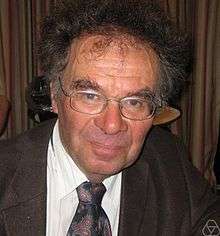Günter Harder
Günter Harder (born 14 March 1938 in Ratzeburg) is a German mathematician, specializing in arithmetic geometry and number theory.
Günter Harder | |
|---|---|
 Günter Harder 2008 | |
| Born | March 14, 1938 Ratzeburg, Germany |
| Alma mater | University of Hamburg |
| Occupation | University mathematics professor |
Education and career
Harder studied mathematics and physics in Hamburg und Göttingen. Simultaneously with the Staatsexamen in 1964 in Hamburg, he received his doctoral degree (Dr. rer. nat.) under Ernst Witt with a thesis Über die Galoiskohomologie der Tori.[1] Two years later he completed his habilitation. After a one-year postdoc position at Princeton University and a position as an assistant professor at the University of Heidelberg, he became a professor ordinarius at the University of Bonn. With the exception of a six-year stay at the former Universität-Gesamthochschule Wuppertal, Harder remained at the University of Bonn until his retirement in 2003. From 1995 to 2006 he was one of the directors of the Max-Planck-Institut für Mathematik in Bonn.
His research deals with arithmetic geometry, automorphic forms, Shimura varieties, motives, and algebraic number theory. He made foundational contributions to the Waldspurger formula.
He was a visiting professor at Harvard University, Yale University, at Princeton's Institute for Advanced Study (IAS) (for the academic years 1966–1967, 1972–1973, 1986–1987, autumn of 1983, autumn of 2006),[2] at the Institut des Hautes Études Scientifiques (I.H.É.S.) in Paris, at the Tata Institute of Fundamental Research in Mumbai, and at the Mathematical Sciences Research Institute (MSRI) at the University of California, Berkeley. He was an Invited Speaker at the ICM in 1970 in Nice with talk Semisimple group schemes over curves and automorphic functions[3] and in 1990 in Kyōto with talk Eisenstein cohomology of arithmetic groups and its applications to number theory.[4] In 1988 he was awarded the Leibniz Prize by the Deutsche Forschungsgemeinschaft. In 2004 Harder received, with Friedhelm Waldhausen, the von Staudt Prize.[5]
For decades, Harder was known to German mathematicians as the Spiritus Rector for a mathematical workshop held for one week in spring and one week in autumn; the workshop, sponsored by the Mathematical Research Institute of Oberwolfach, introduced young mathematicians and scientists to important new developments in pure mathematics and mathematical sciences.
With Ina Kersten, he is a co-editor of the collected works of Ernst Witt.
Harder's doctoral students include Kai Behrend, Maria Heep-Altiner and Jörg Bewersdorff.
Selected publications
- A Gauss-Bonnet formula for discrete arithmetically defined groups. Ann. Sci. École Norm. Sup. (4) 4 (1971), 409–455, (online).
- Chevalley groups over function fields and automorphic forms. Ann. of Math. (2) 100 (1974), 249–306, JSTOR.
- with M. S. Narasimhan: On the cohomology groups of moduli spaces of vector bundles on curves. Math. Ann. 212 (1974/75), 215–248 (online)
- with R. Langlands, M. Rapoport: Algebraische Zyklen auf Hilbert-Blumenthal-Flächen. J. Reine Angew. Math. 366 (1986), 53–120 (online).
- Eisenstein cohomology of arithmetic groups. The case GL2. Invent. Math. 89 (1987), no. 1, 37–118, doi:10.1007/BF01404673
- with Mark Goresky, Robert MacPherson: Weighted cohomology. Invent. Math. 116 (1994), no. 1-3, 139–213, doi:10.1007/BF01231560
- Eisensteinkohomologie und die Konstruktion gemischter Motive, Lecture Notes in Mathematics, volume 2049, Springer 1993, ISBN 9783540574088, doi:10.1007/BFb0090305
- Lectures on Algebraic Geometry, 2 volumes:
- Sheaves, Cohomology of Sheaves, and Applications to Riemann Surfaces, 2nd edition, Vieweg+Teubner 2011, ISBN 9783834818447, doi:10.1007/978-3-8348-8330-8,
- Basic Concepts, Coherent Cohomology, Curves and their Jacobians, Vieweg+Teubner 2011, ISBN 9783834804327, doi:10.1007/978-3-8348-8159-5.
- with Jan Hendrik Bruinier, Gerard van der Geer, Don Zagier The 1-2-3 of modular forms, Springer Verlag 2008, ISBN 978-3-540-74117-6[6] (contains Harder's contribution A Congruence between a Siegel and an elliptic modular form, doi:10.1007/978-3-540-74119-0_4)
References
- Günter Harder at the Mathematics Genealogy Project
- Günter Harder | Institute for Advanced Study
- Harder, Günter, "Semisimple group schemes over curves and automorphic functions." Archived 2017-02-02 at the Wayback Machine Actes, Congrès intern. Math. Tome 2 (1970): 307–312.
- Harder, Günter. "Eisenstein cohomology of arithmetic groups and its applications to number theory." In Proceedings of the International Congress of Mathematicians, vol. 1, pp. 779–790. 1990.
- Günter Harder | Max Planck Institute for Mathematics
- Folsom, Amanda (2009). "Review: The 1-2-3 of modular forms by J. H. Bruinier, G. van der Geer, G. Harder, and D. Zagier" (PDF). Bull. Amer. Math. Soc. (N.S.). 46 (3): 527–533.